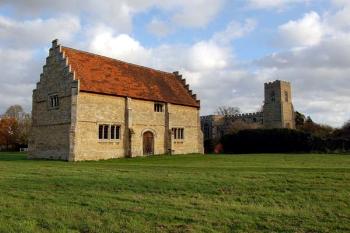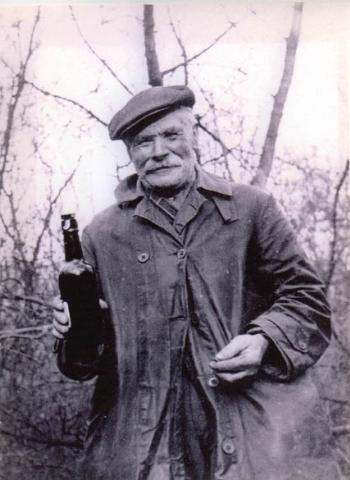Willington Introduction

Willington stables with the church behind - November 2006
Landscape
The parish contains just over 1,600 acres (672 hectares) of which around half consists of arable land, the soil being gravel and the subsoil gravel and sand as one would expect in a valley so close to a principal river (the Great Ouse forms the northern boundary of the parish); the highest point of the parish at Mox Hill is just 213 feet above sea level.
Name
Willington is first mentioned in the Domesday Book of 1086 when it is called Welitone. This is probably derived from the Old English welig-tun meaning willow farm.
Domesday
Hugh de Beauchamp, later Baron of Bedford, held the Manor of Willington in 1086 and had no tenant. The manor consisted of ten hides and comprised 13 villagers and 8 slaves. The manor included a mill, worth 12/- and 100 eels and woodland for 40 pigs. Willington was one of the few Bedfordshire manors to be worth more in 1086 (£7) than in 1066 (£6), though it had only been worth £2 when de Beauchamp acquired it, due to the depredations of William I's armies. Before the Conquest the manor had been held by a thegn of King Edward the Confessor called Askell.

Willington dovecote in November 2006
Willington Manor
On the subdivision of the Barony of Bedford (created for the de Beauchamps by King William II) in 1265 Willington Manor passed to Maud de Beauchamp, wife of Roger de Mowbray. Her second husband Roger Lestrange held Willington until his death in 1311 when John de Mowbray succeeded him. In 1316 he settled it for life on his wife Aliva’s father William de Braose. John de Mowbray was hanged at York in 1322 for joining in Lancaster’s rebellion against his nephew Edward II. His land was taken by the Crown and granted to Edward's favourite (rumoured to be his lover) Hugh le Depenser. However Edward III, on his accession in 1327, restored the Manor to John, son of John de Mowbray, who acknowledged the right of Sir Richard de Peshale, the second husband of his mother in 1328. However, acknowledging the right did not prevent John de Mowbray from raiding the manor, in 1329 he took 24 horses, sixty oxen, twelve cows, 500 sheep and 200 pigs. There was another raid in 1332.
In 1362 after the death of John de Mowbray the right of the manor was granted to his second wife Elizabeth. The Mowbrays held the manor until the death of Anne Mowbray in 1483, when it passed to the Howard family. When their estates were forfeited after the Battle of Bosworth in 1485 (they had supported the loser, Richard III) the Manor was granted to John de Vere, Earl of Oxford, but was restored to Thomas Howard when he was released from prison in 1489. Thomas Howard's son, also Thomas, succeeded to the manor in 1524 and sold it in 1529 to Sir John Gostwick whose ancestors in Willington can be traced back to 1209. Sir John ws a figure of a certain amount of national importance. He was Master of the Horse to Cardinal Thomas Wolseley, Archbishop of York and chief minister to King Henry VIII and later Treasurer of First Fruits and Tenths (also known as annates - a taxation on the profits of a priest's first year in office - payable to the Pope before the Reformation, the to the Crown). When he died in 1545 the Manor passed to his son William who died the same year, then to his brother William who died in 1549. It is Sir John who is credited with having built the dovecote (now owned by the National Trust) as well as another substantial building nearby, the function of which is unclear but seems to have consisted of a suite of rooms above a stable. Both dovecote and stables seem to have been built in the 1530s, as demonstrated by dendrochronology, perhaps using stone from the recently dissolved Newnham Priory. They would have been brand new when Henry VIII visited Gostwick and stayed at the Manor in 1541.
The manor was in the ownership of the Gostwick family for 202 years before William Gostwick, (heir to his grandfather who was Sheriff of Bedfordshire 1679- 80 and MP for the County 1698 – 1713) sold it in 1732 to Sarah, Duchess of Marlborough. The executors of John, 4th Duke of Bedford purchased the manor, and a large part of the village with it, from the Duke of Marlborough in 1779 and the manor remained with the Dukes of Bedford until 1902 when it was sold to George & James Keeble of Peterborough and subsequently subdivided. The map shown is a photograph of part of the estate map drawn up for the purchase by the Duke of Bedford's executors in 1779 - it shows the church in the top right and Church Road including the turns into Balls Lane and Station Road.

local character Bertie Bygraves
Population
In 1086, as described above it contained 21 men. To get a true idea of the total population one probably has to multiply this figure by a factor of at least four to account for their dependents - giving a total population of over 80 - which compares well with other Bedfordshire parishes at this date. However, in more recent history Willington has never been a large or populous village as the following population statistics demonstrate:
1801: 229 1851: 290 1901: 204 1951: 475 2001: 784
The major increase in population occurred, not surprisingly in the 1960s, the population rising from 510 in 1961 to 718 in 1971.